A History of the County of Chester: Volume 5 Part 2, the City of Chester: Culture, Buildings, Institutions. Originally published by Victoria County History, London, 2005.
This free content was digitised by double rekeying. All rights reserved.
J S Barrow, J D Herson, A H Lawes, P J Riden, M V J Seaborne, 'Leisure and culture: Places of entertainment', in A History of the County of Chester: Volume 5 Part 2, the City of Chester: Culture, Buildings, Institutions, ed. A T Thacker, C P Lewis (London, 2005), British History Online https://www.british-history.ac.uk/vch/ches/vol5/pt2/pp269-273 [accessed 30 April 2025].
J S Barrow, J D Herson, A H Lawes, P J Riden, M V J Seaborne, 'Leisure and culture: Places of entertainment', in A History of the County of Chester: Volume 5 Part 2, the City of Chester: Culture, Buildings, Institutions. Edited by A T Thacker, C P Lewis (London, 2005), British History Online, accessed April 30, 2025, https://www.british-history.ac.uk/vch/ches/vol5/pt2/pp269-273.
J S Barrow, J D Herson, A H Lawes, P J Riden, M V J Seaborne. "Leisure and culture: Places of entertainment". A History of the County of Chester: Volume 5 Part 2, the City of Chester: Culture, Buildings, Institutions. Ed. A T Thacker, C P Lewis (London, 2005), British History Online. Web. 30 April 2025. https://www.british-history.ac.uk/vch/ches/vol5/pt2/pp269-273.
In this section
PLACES OF ENTERTAINMENT
Assembly Rooms
For most of the 18th century the most fashionable winter assemblies in Chester as well as the summer balls which were a feature of race week were held at the Exchange. (fn. 1) Later in the century the Exchange came to cater mainly for tradespeople, (fn. 2) and after c. 1815 subscription assemblies for the gentry were invariably held instead at the Royal Hotel or the Albion Hotel. (fn. 3) By the mid 19th century the Exchange had virtually no social function. (fn. 4) Booth Mansion in Watergate Street housed a rival assembly room in the 1740s and 1750s, and new rooms were built by public subscription at the Talbot Inn, Eastgate Street, in 1777. (fn. 5)
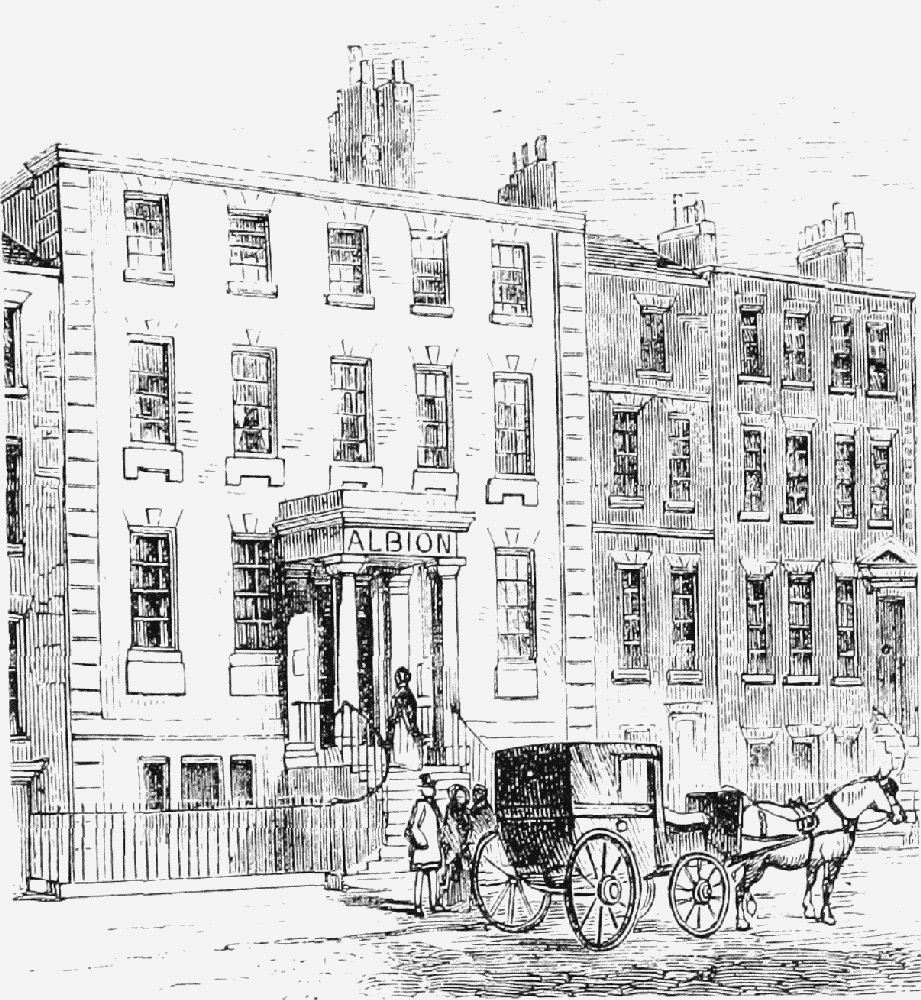
Albion Hotel, Lower Bridge Street, 1856.
The decisive abandonment of the Exchange for the most exclusive events came about because of politics. (fn. 6) Soon after the 1784 general election the Independents built the Royal Hotel behind the Talbot as their headquarters, (fn. 7) and the Grosvenors reacted in 1788 by buying the Talbot itself. (fn. 8) On the renewal of party conflict in 1807 the Independents held their assemblies and dinners at the Royal, leaving what was called the Grosvenor assembly at the Exchange. (fn. 9) Earl Grosvenor then bought the Royal Hotel in 1815, (fn. 10) to serve as his family's political and social headquarters in Chester, (fn. 11) forcing the Independents out. By 1830 political reconciliation had worked through to social life. In 1829, for example, a fancy-dress ball at the Royal during the autumn music festival 'commanded an immense company'. (fn. 12) Around that time the Royal had two assembly rooms, a newsroom, coffee room, and two billiard rooms. (fn. 13) About 1830 its main assembly room commonly attracted up to 300 gentry and was the usual venue for concerts. (fn. 14) The Talbot and the Royal merged under the ownership of the Grosvenors and when the two were rebuilt and extended as the Grosvenor Hotel in 1863–5 the new establishment incorporated the old assembly room. (fn. 15)
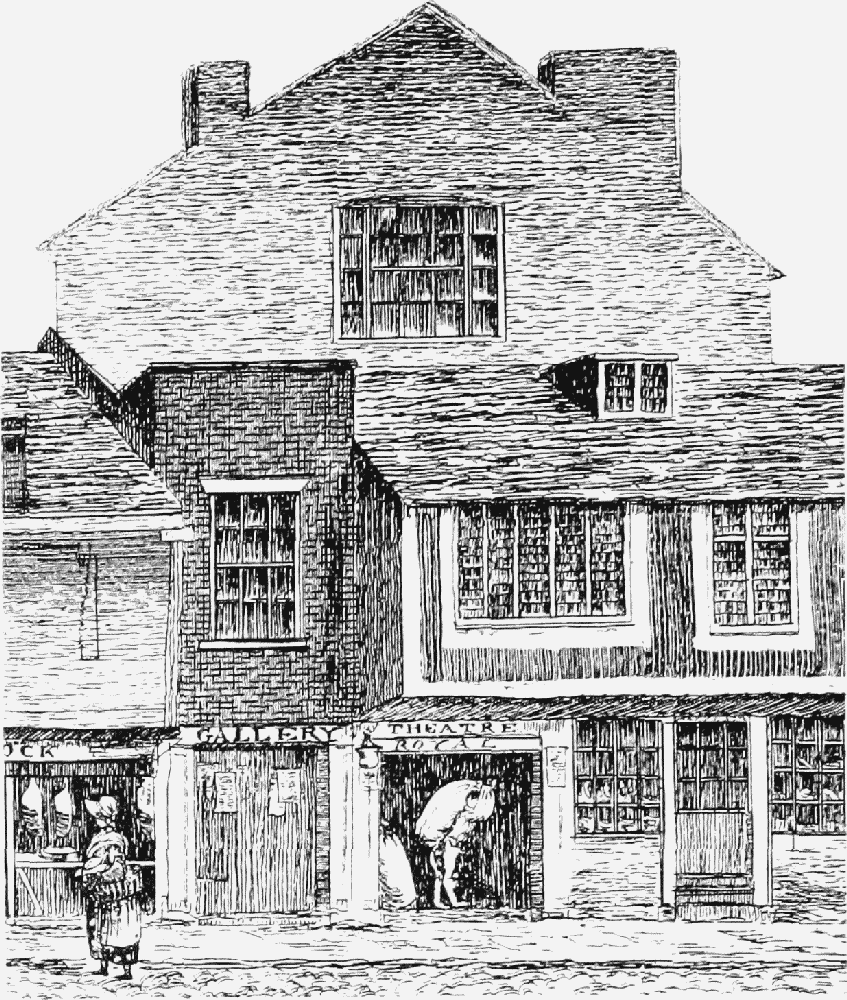
Theatre Royal entrance, Northgate Street, c. 1810.
On their expulsion from the Royal Hotel, the Independents moved after 1815 to the Albion Hotel in Lower Bridge Street (Fig. 164), (fn. 16) converted from a private house to include a large assembly room. Its 2 a. of gardens stretched back to the city wall, and a newsroom and billiard room were accommodated in a house across the street. It became a fashionable place for ladies on summer afternoons, (fn. 17) but its trade was drawn away by the diversion of through traffic along Grosvenor Street after 1832, and after a lengthy decline it closed in 1867. (fn. 18)
Theatres and Music Halls
From the 17th century to the mid 19th the principal theatre in Chester was in the former St. Nicholas's chapel, commonly known as the Wool Hall. (fn. 19) Shakespeare's Tempest and a comedy were performed in 1692, by when there was a regular summer season. (fn. 20) Richard III was on the bill in 1727 and a comic opera, The Maid of the Mill, in 1769. (fn. 21) The 1751 season included a visiting company of rope-dancers and tumblers, who also staged a pantomime. (fn. 22) There were other venues in the mid 18th century. In 1752 the Exchange put on Richard III, vocal and instrumental music, and a 'tragi-comi-pastoral farcical operatical entertainment' called The What D'ye Call It. (fn. 23) The old real tennis court in Foregate Street was used by a different travelling company from London from before 1750 until 1768. (fn. 24)
The Wool Hall was refitted as the New Theatre in 1773. The proprietors ensured its continuance in the teeth of corporation hostility by obtaining a patent in 1777 licensing it as the Theatre Royal (Fig. 165). (fn. 25) Under that name it provided the main, perhaps the only, venue throughout the years that play-going was fashionable among county and civic society, opening each year to coincide with the peaks of Chester's season in the winter and during race week. (fn. 26) It was managed as part of a circuit which included Newcastle, Lancaster, Whitehaven, and Preston. (fn. 27) The programmes included Shakespeare, Garrick, Sheridan, and Otway, new comedies and farces, and pantomime, and all the leading actors of the day trod its boards between the 1780s and the 1820s, among them Edmund Keen, Sarah Siddons, and Grimaldi. (fn. 28) An extra tier of boxes was added in 1828. (fn. 29)
The lease of the Theatre Royal expired in 1853, (fn. 30) and it was refitted as the 1,400-seater Music Hall to designs by James Harrison, opening in 1855 to extravagant praise of its luxury and elegance. (fn. 31) Its managers, the Chester booksellers Messrs. Phillipson and Goulder, concentrated on musical performances – orchestral, choral, and brass-band (fn. 32) – to the apparent exclusion of theatre. It became a cinema in 1921. (fn. 33)
A large wooden building on the east side of City Road was used from c. 1866 for occasional plays and circuses. From 1869 it was called the Oxford Music Hall and in 1878 was refurbished as the Prince of Wales Theatre. It was let for short runs to popular entertainers, including circuses, waxworks, theatre companies, and 'Madame Beatrice's Frou Frou Company', all aiming for a lower niche in the market than the Music Hall. In 1882 it was replaced by an unremarkable brick building, the Royalty Theatre, which seated 2,000. Its owner from 1896, J. W. Carter, (fn. 34) floated it as a limited company that year, boasting of its monopoly of popular amusements in the city. (fn. 35) It occasionally offered high quality theatre, (fn. 36) but had opened with a pantomime and the usual fare in the early 20th century was music hall, variety, revues, melodramas, and farces. (fn. 37) By the 1960s amateur opera alternated with professional wrestling, and pantomimes with bingo and striptease. (fn. 38) In 1978 it began a brief incarnation as a skateboard rink (fn. 39) and in the 1990s housed a nightclub.
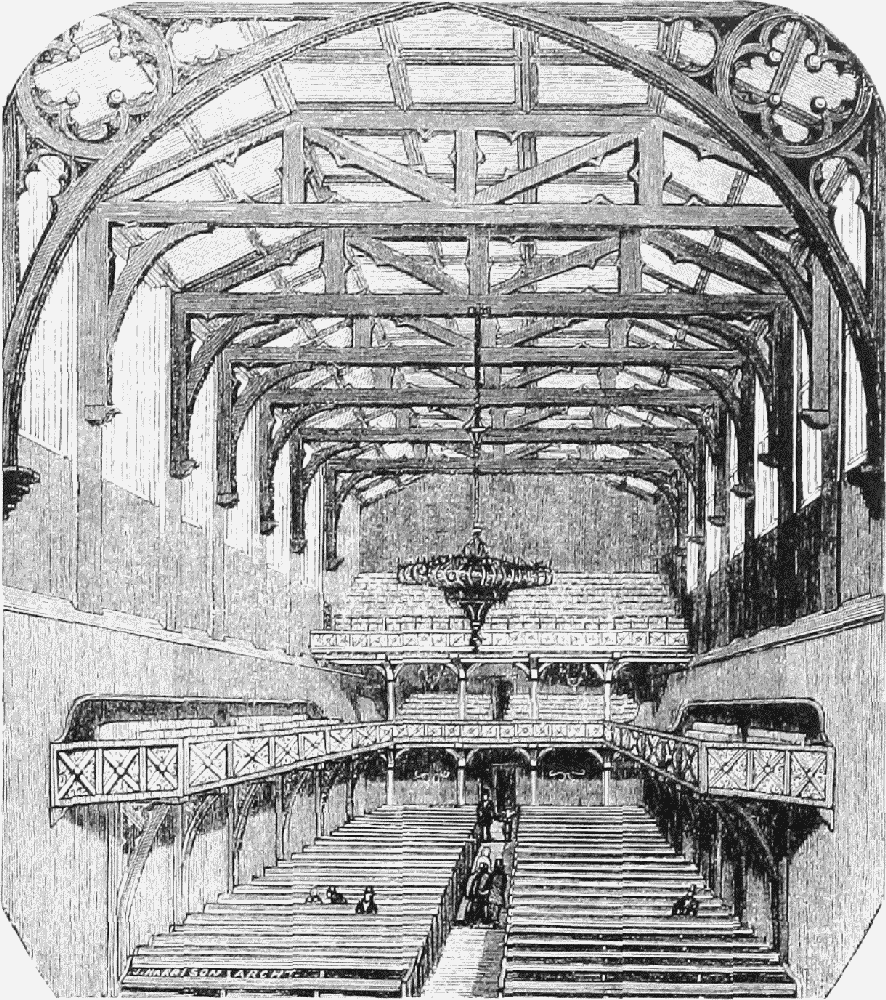
Music Hall, as refitted in 1855
The Gateway Theatre was built as part of the 1960s Forum shopping centre jointly by the developer and the city council, and opened in 1968. Subsidized by public funds and commercial sponsorship, it put on a varied programme of theatre on a main stage and in a studio. (fn. 40)
Chester Theatre Club, founded in the 1940s, bought the former Christ Church National school in 1962 and converted it into the Little Theatre, where it put on six amateur productions a year in the 1990s. (fn. 41)
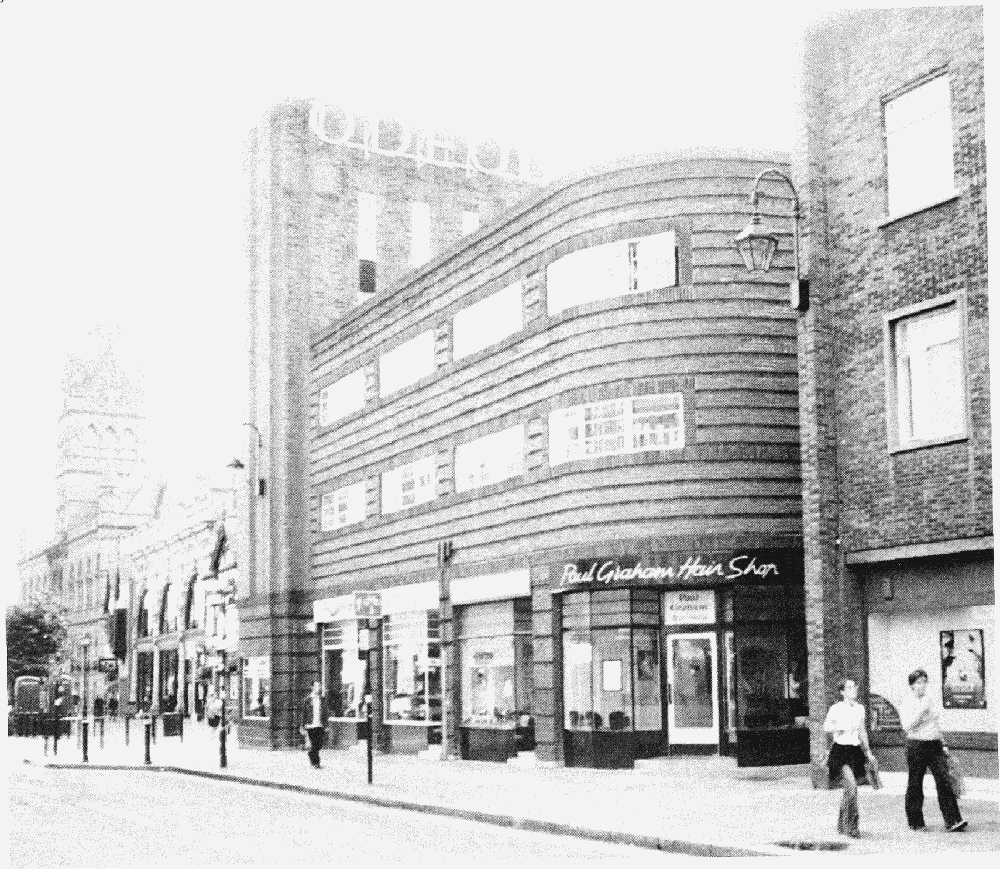
Odeon cinema
Cinemas (fn. 42)
William Freize-Green's claim to have shown the first ever successful moving pictures on 26 June 1890 at Chester town hall has been dismissed as either selfdeluding or fraudulent. (fn. 43) In the 1900s showmen who visited Chester regularly exhibited films, (fn. 44) but the first permanent cinema was Will Hunter's Picturedrome, in the Corn Exchange, Eastgate Street, opened in 1909. (fn. 45) The Royalty Theatre, the Music Hall, and other venues also showed films. (fn. 46) The only purposebuilt cinema before 1914 was the Glynn Picture Hall, opened in 1911 by a Shrewsbury company in a corrugated iron building seating 750 behind no. 110 Foregate Street. It was given a black-and-white vernacular front by the Chester architects Minshull and Muspratt. (fn. 47)
After 1918 there was much new investment in cinemas. (fn. 48) The Music Hall was refitted as an 820seater in 1921. (fn. 49) Pat Collins, before the war a travelling film exhibitor, opened the 1,050-seat Cinema De Luxe at no. 95 Brook Street in 1921, behind a black-andwhite frontage designed by W. Matthews Jones. (fn. 50) The Park Cinema in St. Mark's Road, Saltney, was a 450–seater opened in 1923 by Messrs. Booth and Grierson. (fn. 51) The Picturedrome closed when its lease expired in 1924, (fn. 52) leaving four cinemas operating.
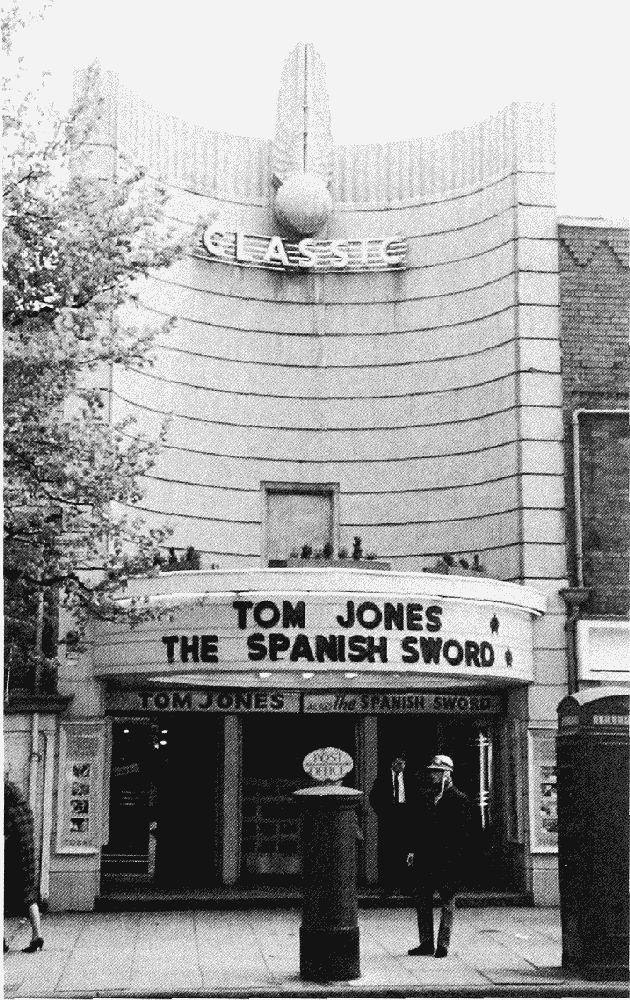
Classic cinema, 1964
The early picture houses mostly had local owners, but the national cinema circuits moved into the city from the late 1920s, starting with the General Theatre Corporation, which in 1928–9 bought the Music Hall, the Glynn Picture Hall, and the Cinema De Luxe (renamed the Majestic in 1926). (fn. 53) The first of the 1930s 'supers' was the Gaumont Palace, a 2,000–seater auditorium with an opulent interior behind the black-and-white entrance front in Brook Street, opened in 1931; (fn. 54) next, in 1936, was the 1,750–seater Odeon, whose company architect toned down the circuit's usual modernism for a sensitive site in Northgate Street; (fn. 55) finally, in 1937, Associated British Cinemas Ltd. built the Regal, seating almost 2,000 in an equally restrained modernist style at the corner of Foregate Street and Love Street. (fn. 56) The Tatler News Theatre, erected at no. 56 Foregate Street in 1936, was one of the few provincial newsreel cinemas until it was taken over by the Classic chain c. 1957, renamed, and switched to feature films and pornography. It seated 530 and had a white-tiled neo-classical exterior. (fn. 57)
Only the Glynn succumbed to the increased competition, closing in 1931; (fn. 58) the building survived in 1994 but was badly neglected. Cinema closures began in earnest in the mid 1950s. The Majestic was converted, briefly, to a dance hall after it closed in 1956, (fn. 59) and only the front part survived as a shop. The Music Hall (fn. 60) and the Gaumont closed in 1961, the latter becoming briefly a ten-pin bowling alley, then a bingo hall, (fn. 61) which it remained in 1994. The Park closed in 1963, (fn. 62) the Classic closed in 1970 and was demolished in 1971, (fn. 63) and the Regal (renamed the A.B.C. in 1959) (fn. 64) became a twin-screen cinema in 1980, was sold and renamed the Cannon in 1987, and closed in 1990. (fn. 65) That left only the Odeon, remodelled to have three screens in 1976 and five in 1991, (fn. 66) and Metro-Goldwyn-Mayer's six-screen multiplex, opened as a replacement for the Cannon in 1990 at Greyhound Park, Sealand Road. (fn. 67)